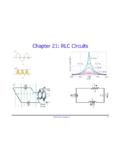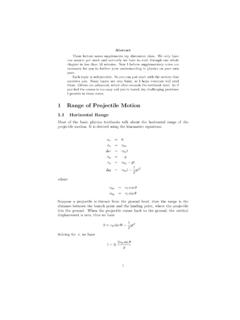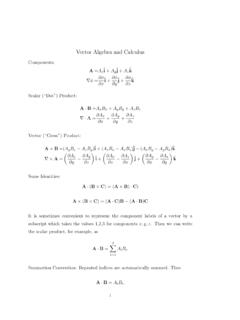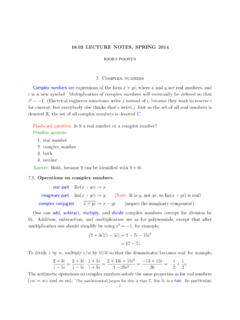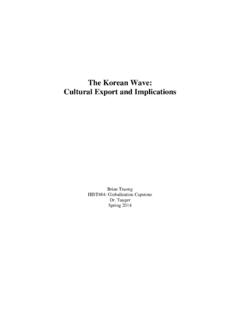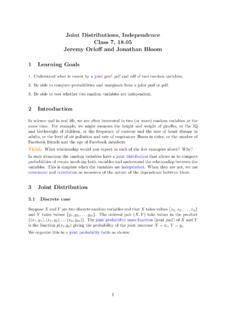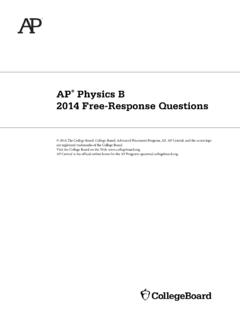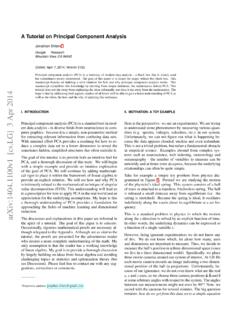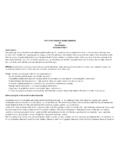Transcription of Circular Motion Tangential & Angular Acceleration
1 Rick Field 2/6/ 2014 University of FloridaPHY 2053 Page 1 Circular MotionTangential & Angular Acceleration rvt=The arc length s is related to the angle (in radians = rad) as follows: Tangential Acceleration : rs= tradialtradialtotaraaaa+ =+=rrr rdtdrdtdvatt===dtdtt = = 0lim(radians/s2) Overall Acceleration : Tangential VelocityThe Tangential velocity vtis related to the Angular velocity as follows: The Tangential Acceleration atis related to the Angular Acceleration as follows: at ar Radial Axis r rvt=tv22tradialtottotaaaa+==rRadial AccelerationTangential AccelerationRick Field 2/6/ 2014 University of FloridaPHY 2053 Page 2 at ar Radial Axis rAngular Equations of Motion Angular Equations of Motion (constant ).
2 22100)(ttt ++=()0202)(2)( = ttIf the Angular Acceleration is constant thentt +=0)( =)(tRadial AccelerationTangential Acceleration22100)(tatvststt++=tavtvttt+ =0)( rtat=)(()0202)(2)(stsavtvttt = )()(2trtaradial =rtvtatradial/)()(2=(radians/s2)(m/s2)(r adians/s)(radians)(m/s)(m)(m/s2)(m/s2)Ri ck Field 2/6/ 2014 University of FloridaPHY 2053 Page 3 Angular Equations of Motion Angular Equations of Motion (constant ): 22100)(ttt ++=()0202)(2)( = ttLet N = Number of revolutions (rev)tt +=0)( =)(t222100)()(ttfNtN ++=tftf)()(20 += 2()02202)()(2)(NtNftf = (rad/s2)(rev/s2)(rad/s)(rad)(rev/s)(rev) Let f = Number of revolutions per second 2)()(ttf= 2)()(ttN=(frequency)Rick Field 2/6/ 2014 University of FloridaPHY 2053 Page 4 Angular Equations: Examples A disk rotates about its central axis starting from rest at t = 0 and accelerates with constant Angular Acceleration .
3 At one time it is rotating at 4 rev/s; 60 revolutions later, its Angular speed is 16 rev/s. Starting at t = 0, what is the time required to complete 64 revolutions?Answer: t = 8 seconds An astronaut is being tested in a centrifuge. The centrifuge has a radius R and, in starting from rest at t = 0, rotates with a constant Angular Acceleration = rad/s2. At what time t > 0 is the magnitude of the Tangential Acceleration equal to the magnitude of the radial Acceleration ( Acceleration )?Answer: t = 2 seconds22210)()(tNtN = ()()2220202/2602)/4()/16()(2)(2srevrevsr evsrevNtNftf= = = ssrevrevNtNt8)/2()64(2)())((2220== = RatRtRtatradial====222)()(ssradt2 Rick Field 2/6/ 2014 University of FloridaPHY 2053 Page 5 Exam 2 spring 2011:Problem 2 A race car accelerates uniformly from a speed of 40 m/s to a speed of 58 m/s in 6 seconds while traveling around a Circular track of radius 625 m.
4 When the car reaches a speed of 50 m/s what is the magnitude of its total Acceleration (in m/s2)?Answer: 5% Right: 49%smaaasmmsmRvasmssmsmttvvarttotrt/5/46 25)/50(/36)/40()/58(22221212=+===== = =Rick Field 2/6/ 2014 University of FloridaPHY 2053 Page 6 Gravitation: Circular Orbits (M >> m)Fgv M m r3rGM= 222 mrrvmmarGmMFradialg==== Kepler s Third Law: For Circular orbits the gravitational force is perpendicular to the velocity and hence the speed of the mass m is constant. The force Fgis equal to the mass times the radial ( ) Acceleration as follows:(speed, constant)Assume M >> m so that the position of M is fixed!
5 (period of rotation)2vGMr=rGMv=GMrGMrrvrT3222 ===GMrT3224 =( Angular velocity, constant)For Circular orbits r, v, and are also period squared is proportional to the radius cubed.(radius of the orbit, constant)Fg vmM m rmCM rMVM In general both masses rotate about the center-of-mass and the formulas are more complicated!Rick Field 2/6/ 2014 University of FloridaPHY 2053 Page 7 Circular Orbits:ExampleAnswer: 8T Two satellites are in Circular orbit around the Earth. The first satellite has mass M1and is travelling in a Circular orbit of radius R1.
6 The second satellite has mass M2= M1is travelling in a Circular orbit of radius R2= 4R1. If the first satellite completes one revolution of the Earth in time T, how long does it take the second satellite to make one revolution of the Earth? 1312214 GMRT =211312131223222264464)4(44 TGMRGMRGMRT==== TTT8812==Rick Field 2/6/ 2014 University of FloridaPHY 2053 Page 8 Circular Orbits:Example Two diametrically opposed masses m revolve around a circle of radius R. A third mass M = 2m is located at the center of the circle.
7 What is the period T of rotation for this system of three masses?GmRT334 =m RM = 2m m Answer: m RM = 2m m F()RvmmamMRGmRGmRGmMFradialgrav2412222)2 (==+=+=GmRGmRRmmGRRmMGRRvRT3414134942)2( 2)(22 ==+=+==RmMGv)(41+=


